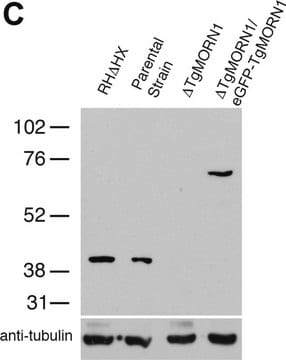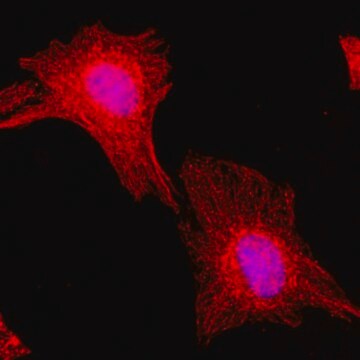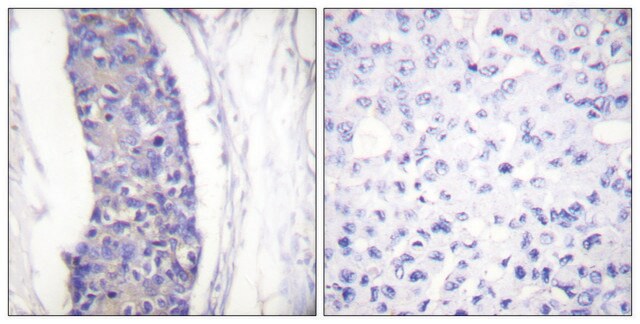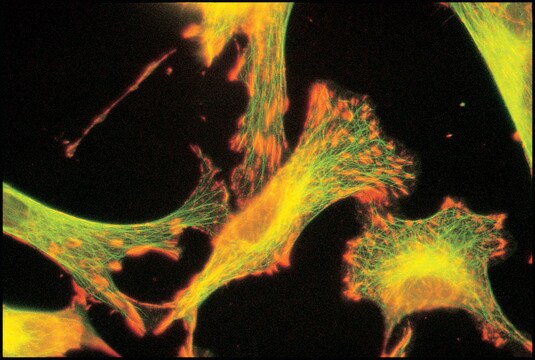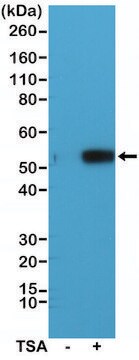Key Documents
T6199
Anti-α-Tubulin antibody, Mouse monoclonal

clone DM1A, purified from hybridoma cell culture
Synonim(y):
Monoclonal Anti-α-Tubulin
About This Item
Polecane produkty
pochodzenie biologiczne
mouse
Poziom jakości
białko sprzężone
unconjugated
forma przeciwciała
purified immunoglobulin
rodzaj przeciwciała
primary antibodies
klon
DM1A, monoclonal
Postać
buffered aqueous solution
masa cząsteczkowa
antigen ~50 kDa
reaktywność gatunkowa
yeast, mouse, amphibian, human, rat, chicken, fungi, bovine
opakowanie
antibody small pack of 25 μL
rozszerzona walidacja
independent ( Antibodies)
Learn more about Antibody Enhanced Validation
stężenie
~1 mg/mL
metody
immunocytochemistry: 0.5-1 μg/mL using cultured chicken fibroblasts (CFB)
immunohistochemistry: suitable
immunoprecipitation (IP): suitable
microarray: suitable
western blot: 0.5-1 μg/mL using total tissue extract from chicken gizzard
izotyp
IgG1
numer dostępu UniProt
Zastosowanie
research pathology
Warunki transportu
dry ice
temp. przechowywania
−20°C
docelowa modyfikacja potranslacyjna
unmodified
informacje o genach
human ... TUBA4A(7277)
mouse ... Tuba1a(22142)
rat ... Tuba1a(64158)
Szukasz podobnych produktów? Odwiedź Przewodnik dotyczący porównywania produktów
Opis ogólny
Tubulin is the major building block of microtubules. This intracellular, cylindrical, filamentous structure is present in almost all eukaryotic cells. Microtubules function as structural and mobile elements in mitosis, intracellular transport, flagellar movement, and the cytoskeleton. Tubulin is a heterodimer that consists of α-tubulin and β-tubulin. Both subunits have a molecular weight of approx. 50 kDa and share considerable homology. In addition to α- and β-tubulin, several other tubulins have been identified, bringing the number of distinct tubulin classes to seven. Most of these tubulins have distinct subcellular localization and an emerging diverse set of functions. Out of the seven different tubulins four new members of the tubulin family were identified recently, which consist of δ, ξ, η and ε-tubulin. η and ε-tubulins were discovered by database searches. Microtubular systems contain at least three α-tubulin isoforms. Two isoforms are coded by two α-tubulin genes, which are both transcribed and code for extremely similar proteins. The third isoform is generated by post-translational modification. At least three modifications of tubulin subunits have been described: the phosphorylation of β-tubulin from brain, the removal of the carboxy terminal tyrosine form a-tubulin in vertebrate tissues, and the acetylation of the amino group of lysine(s) in α-tubulin.
α -tubulin, also called tubulin α 4a (TUBA4A), is mapped to human chromosome 2q35. The gene codes for a member of the α -tubulin family, and contains 448 amino acids. α-subunit of tubulin has molecular weight of 50,000.
Monoclonal antibodies recognizing α-tubulin, together with monoclonal antibodies to other tubulin types (β, β-tubulin isotype I +II, β-tubulin isotype III, tyrosine tubulin, and the acetylated form of α-tubulin) provide a specific and useful tool in studying the intracellular distribution of tubulin and the static and dynamic aspects of cytoskeleton.
Specyficzność
Immunogen
Zastosowanie
Działania biochem./fizjol.
α-Tubulin or tubulin α 4A (TUBA4A) plays an essential role in cell growth and division. It is also implicated in various cellular processes, such as cell motility, signaling development and cell shape maintenance. Mutation in TUBA4A is associated with the development of various types of cancers, such as oral cancer, breast cancer, rectal cancer, lung cancer and prostate cancer. In addition, variation in the TUBA4A leads to sporadic amyotrophic lateral sclerosis (ALS).
Postać fizyczna
Uwaga dotycząca przygotowania
Inne uwagi
Oświadczenie o zrzeczeniu się odpowiedzialności
Nie możesz znaleźć właściwego produktu?
Wypróbuj nasz Narzędzie selektora produktów.
Kod klasy składowania
10 - Combustible liquids
Klasa zagrożenia wodnego (WGK)
WGK 2
Temperatura zapłonu (°F)
Not applicable
Temperatura zapłonu (°C)
Not applicable
Certyfikaty analizy (CoA)
Poszukaj Certyfikaty analizy (CoA), wpisując numer partii/serii produktów. Numery serii i partii można znaleźć na etykiecie produktu po słowach „seria” lub „partia”.
Masz już ten produkt?
Dokumenty związane z niedawno zakupionymi produktami zostały zamieszczone w Bibliotece dokumentów.
Klienci oglądali również te produkty
Nasz zespół naukowców ma doświadczenie we wszystkich obszarach badań, w tym w naukach przyrodniczych, materiałoznawstwie, syntezie chemicznej, chromatografii, analityce i wielu innych dziedzinach.
Skontaktuj się z zespołem ds. pomocy technicznej


